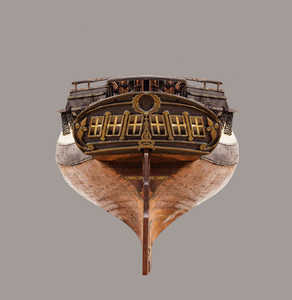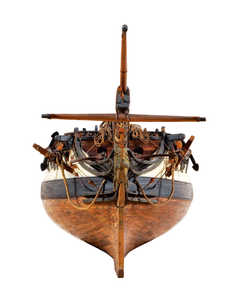Frigates. Seventeenth - Eighteenth centuries
Experiments to come up with a new type of warship led to the development of the “galleried galleon” in the second half of the sixteenth century. However, this oar/sail-driven hybrid did not live up to its promoter’s expectations due to the difficulty of housing the oarsmen and guns on a single deck. However this type of ship, conditioned by the demands of oared propulsion, was particularly fast; it had excellent hydrodynamics and the sheerless freeboard was not slowed by a bow wind. Once the oars had been removed from the design, new innovations were introduced to the hull, leading to what came to be known as the frigate, which was fully developed during the eighteenth century.

Oared galleon. 200-tonne ship probably built in St Jean de
Luz around 1565. She had three masts and 22 oars on each side.
This was the typical galleon of the Bay of Biscay, but notably more
stylised, with a much longer keel relative to the beam. In this ship
we can see the dramatic reduction in the freeboard, initially to
make the work of the oarsmen easier. These changes were later
found to be an advantage for sailing the ship as well. © José Lopez

Frigate belonging to the Real Compañía Guipuzcoana de
Caracas. Merchant frigates from Gipuzkoa were the key to the
success of this trading company. They consolidated the transatlantic
transport and economy of the province at a time when pirates,
privateers or enemy fleets were the scourge of transoceanic trade.
The swift Gipuzkoan frigates proved their worth against enemies
and rivals. © José Lopez

Frigates and ships-of-the-line developed quite a similar rig
and outline. However, frigates were easily recognisable by having
just one line of guns. The number of sails was increased, with the
addition of triangular sails (lateens) between the masts, considerably
improving the ship's ability to sail against the wind. © José Lopez

The frigate has a clean line and single gun deck. A boom was
added to the bowsprit to take the strain of the rigging and the
recently introduced jibs. With the extra rigging the mizzen lateen
became cumbersome and at the end of the eighteenth century it
was replaced by a fore-and-aft sail. © José Lopez







